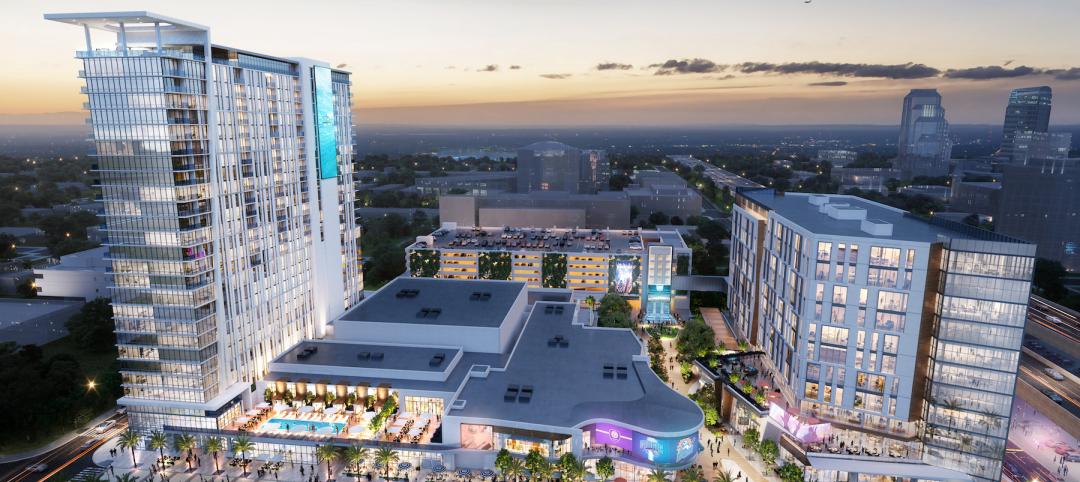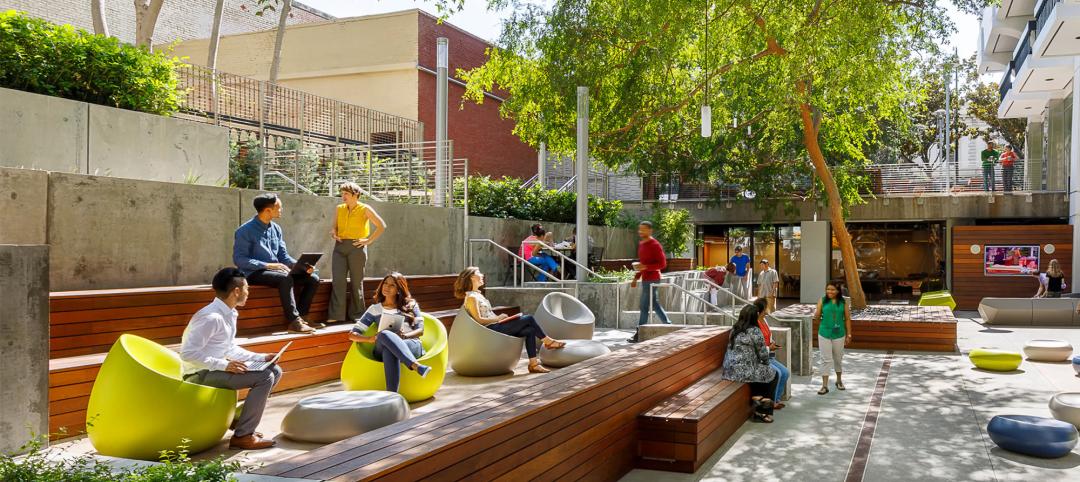
It was supposed to be the perfect new office. In July 2003, Two Rivers Marketing Group of Des Moines, Iowa, began working with Shiffler Associates Architects on a 14,000-sf building to house their rapidly growing marketing firm. Over the next six months they put together an innovative program that drew on unprecedented amounts of employee feedback. Construction kicked off in June 2004; by December, their dream office was close to being reality.
 |
| PHOTOS: CAMERON CAMPBELL |
Then, on December 20, 2004, the virtually complete building caught fire and burned to the ground, leaving Two Rivers Marketing with a soon-to-expire lease and no place to go.
In the aftermath of the fire, the Building Team—Shiffler Associates Architects, with Larson & Larson Construction (GC), The Waldinger Group (M/E engineer), and Korpela Engineering (structural)—came to realize that the fire was something of a mixed blessing: the burnt-out space wouldn't have met the client's needs for long in any case. In six years, the staff had grown from 14 to 60 employees, and the marketing firm was hiring like mad. Clearly, finding a new building to renovate with enough room for expansion was top priority.
Three months later, they found the right place—32,000 sf of steel and glass. Originally constructed in 1935, this former General Motors parts warehouse offered sweeping views of the Iowa State Capitol building and downtown Des Moines. With all square footage on one large floor, the warehouse gave Two Rivers Marketing the opportunity to arrange their staff in an open configuration that separated people by distance, rather than walls, and encouraged collaboration between designers, writers, and account managers.
The firm also felt that the industrial space offered a symbolic connection to their clients—largely industrial-based companies like Bobcat and Ingersoll Rand—in a way that a stuffy, marble-and-mahogany environment would not. Nor did it hurt, given the firm's recent history, that the warehouse was made entirely of noncombustible materials.
 |
 |
| Simple, inexpensive materials were used throughout the interior spaces. The main lobby is clad with plywood panels (top) and semi-transparent corrugated fi berglass walls enclose the mezzanine workspaces (above). PHOTOS: CAMERON CAMPBELL |
With Two Rivers Marketing's lease set to run out at the end of 2005, the design-build team had nine months to not only repair 70 years' worth of lapsed maintenance, but also to transform a raw warehouse into the ideal office space for a fun, hip marketing firm.
The first step was quickly coming up with an architectural program and design that would fit the space. Luckily, the team was able to use the program from the original, burnt-out building. To make the program fit the much larger space, they added a photo studio, a larger break area, and plenty of office room that would allow the company to grow.
Then came the job of updating and repairing the shell of the building to meet codes and energy-efficiency needs. The building's windows—steel sash and single pane, many with concrete sills that had come loose from the masonry below—needed serious work. The team reset all the windows and doweled them into place, replacing the old panes with aluminum frames and insulated glazing. The HVAC system, which at purchase consisted of multiple ceiling-hung furnaces, was replaced with more effective rooftop units.
With the basics taken care of, the team could then move on to aesthetics. In order to build a brand connection with their industrial clientele, Two Rivers chose to maintain the look and feel of the original GM structure. The original concrete floor was polished to a bright sheen. The trim materials used for desks, wall details, and the few dividing walls were chosen for both their industrial character and their ability to maintain a sense of openness. These included plywood and inexpensive corrugated fiberglass panels.
But the team's greatest achievement was the addition of a mezzanine into the building's pre-existing central clerestory. Adding 3,000 sf of extra space, the mezzanine is self-supporting and appears to float on narrow, canted columns. It is divided into a series of “pseudo rooms,” defined enough to give the firm's executives private offices, but tied to the rest of the design's open layout by semi-transparent corrugated fiberglass walls set with open plywood window boxes.
The industrial theme is maintained here, too, by walkways made of steel grating and wire mesh guardrails that reference back to old-fashioned factory catwalks. The space beneath the mezzanine is designed to be an impromptu meeting place, with couches and chair groupings that encourage brainstorming sessions.
Completed last December, the project has won several preservation and design awards. Two Rivers Marketing continues to draw in more new employees, possibly as a result of another renovation element—a full kitchen complete with keg fridge and pool table.
Related Stories
Mixed-Use | Apr 23, 2024
A sports entertainment district is approved for downtown Orlando
This $500 million mixed-use development will take up nearly nine blocks.
AEC Innovators | Apr 15, 2024
3 ways the most innovative companies work differently
Gensler’s pre-pandemic workplace research reinforced that great workplace design drives creativity and innovation. Using six performance indicators, we're able to view workers’ perceptions of the quality of innovation, creativity, and leadership in an employee’s organization.
Laboratories | Apr 15, 2024
HGA unveils plans to transform an abandoned rock quarry into a new research and innovation campus
In the coastal town of Manchester-by-the-Sea, Mass., an abandoned rock quarry will be transformed into a new research and innovation campus designed by HGA. The campus will reuse and upcycle the granite left onsite. The project for Cell Signaling Technology (CST), a life sciences technology company, will turn an environmentally depleted site into a net-zero laboratory campus, with building electrification and onsite renewables.
Mixed-Use | Apr 4, 2024
Sustainable mixed-use districts: Crafting urban communities
As a part of the revitalization of a Seattle neighborhood, Graphite Design Group designed a sustainable mixed-use community that exemplifies resource conversation, transportation synergies, and long-term flexibility.
Office Buildings | Apr 2, 2024
SOM designs pleated façade for Star River Headquarters for optimal daylighting and views
In Guangzhou, China, Skidmore, Owings & Merrill (SOM) has designed the recently completed Star River Headquarters to minimize embodied carbon, reduce energy consumption, and create a healthy work environment. The 48-story tower is located in the business district on Guangzhou’s Pazhou Island.
Adaptive Reuse | Mar 30, 2024
Hotel vs. office: Different challenges in commercial to residential conversions
In the midst of a national housing shortage, developers are examining the viability of commercial to residential conversions as a solution to both problems.
Sustainability | Mar 29, 2024
Demystifying carbon offsets vs direct reductions
Chris Forney, Principal, Brightworks Sustainability, and Rob Atkinson, Senior Project Manager, IA Interior Architects, share the misconceptions about carbon offsets and identify opportunities for realizing a carbon-neutral building portfolio.
Office Buildings | Mar 28, 2024
Workplace campus design philosophy: People are the new amenity
Nick Arambarri, AIA, LEED AP BD+C, NCARB, Director of Commercial, LPA, underscores the value of providing rich, human-focused environments for the return-to-office workforce.
Office Buildings | Mar 27, 2024
A new Singapore office campus inaugurates the Jurong Innovation District, a business park located in a tropical rainforest
Surbana Jurong, an urban, infrastructure and managed services consulting firm, recently opened its new headquarters in Singapore. Surbana Jurong Campus inaugurates the Jurong Innovation District, a business park set in a tropical rainforest.
Adaptive Reuse | Mar 26, 2024
Adaptive Reuse Scorecard released to help developers assess project viability
Lamar Johnson Collaborative announced the debut of the firm’s Adaptive Reuse Scorecard, a proprietary methodology to quickly analyze the viability of converting buildings to other uses.
















